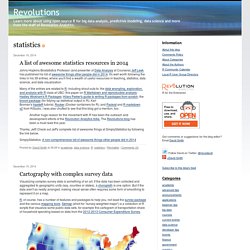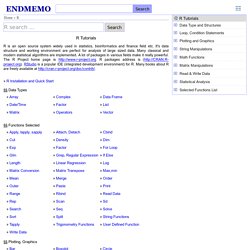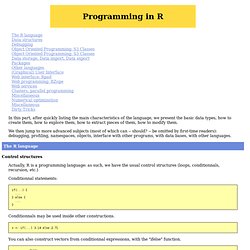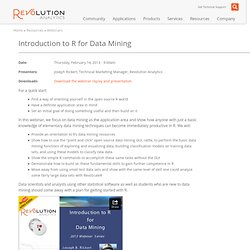

[FRENCH] Data Mining avec R dans un monde libre. R est un langage et un environnement pour les calculs statistiques et leurs représentations graphiques.
![[FRENCH] Data Mining avec R dans un monde libre](http://cdn.pearltrees.com/s/pic/th/data-mining-avec-monde-libre-70843232)
R est similaire au système S qui a été récompensé par le Software System Award de l'ACM (Association for Computing Machinery) et qui est la plate-forme du logiciel commercial S-Plus. Rappelons quelques technologies reconnues par la récompense ACM à savoir UNIX, TeX, PostScript, TCP/IP, World-Wide Web, Tcl/Tk, et Apache. La citation de l'ACM contenait la phrase suivante: «... system, which has forever altered how people analyze, visualize, and manipulate data.» Le but de l'article précédemment paru dans le FI 2/01 [1] était de fournir un point de départ pour les novices intéressés par R [2].
Fin juin 2001, la version 1.3.0 de R est sortie, contenant un portage stable pour MacOS/X [3]. Qu'est-ce que le data mining? «We are drowning in information, but starving for knowledge.» Blog Revolution - statistics. By Terry M.

Therneau Ph.D.Faculty, Mayo Clinic About a year ago there was a query about how to do "type 3" tests for a Cox model on the R help list, which someone wanted because SAS does it. The SAS addition looked suspicious to me, but as the author of the survival package I thought I should understand the issue more deeply.
It took far longer than I expected but has been illuminating. First off, what exactly is this 'type 3' computation of which SAS so deeply enamored? To compute this, one can start by fitting a sufficiently rich model, get predicted values for our age distribution, and then average them. A primary statistical issue with type 3 is the choice of reference. Average population prediction also highlights a serious deficiency in R. R needs a general and well thought out post-fit contrasts function. R news & tutorials from the web.
Blog - Simply Statistics. MOOC - R Programming. MOOC - [FENCH] Introduction à la statistique avec R » Google Tends: R programming. Advanced R. programming. RDataMining.com: R and Data Mining. [FRENCH] Guide de démarrage pour ggplot2. Hadley Wickham signed his book "ggplot2" in my iPad | H.
![[FRENCH] Guide de démarrage pour ggplot2](http://cdn.pearltrees.com/s/pic/th/demarrage-ggplot2-graphique-87570946)
Okumura Le traitement et l’analyse de données sont une part importante des tâches demandées à un bioinformaticien. Code School - Try R. EndMemo. R Tutorials R is an open source system widely used in statistics, bioinformatics and finance field etc.

It's data structure and working environment are perfect for analysis of large sized data. Many classical and modern statistical algorithms are implemented. A lot of packages in various fields make it really powerful. Courses. Programming in R. The R languageData structuresDebuggingObject Oriented Programming: S3 ClassesObject Oriented Programming: S3 ClassesData storage, Data import, Data exportPackagesOther languages(Graphical) User InterfaceWeb interface: RpadWeb programming: RZopeWeb servicesClusters, parallel programmingMiscellaneousNumerical optimizationMiscellaneousDirty Tricks In this part, after quickly listing the main characteristics of the language, we present the basic data types, how to create them, how to explore them, how to extract pieces of them, how to modify them.

We then jump to more advanced subjects (most of which can -- should? -- be omitted by first-time readers): debugging, profiling, namespaces, objects, interface with other programs, with data bases, with other languages. R Programming - Manuals. UCLA. The R Project. CRAN: Contributed Documentation. It's crantastic! Plotly. R reference card. Cookbook for R. R Programming. Welcome to the R programming Wikibook This book is designed to be a practical guide to the R programming language[1].

R is free software designed for statistical computing. There is already great documentation for the standard R packages on the Comprehensive R Archive Network (CRAN)[2] and many resources in specialized books, forums such as Stackoverflow[3] and personal blogs[4], but all of these resources are scattered and therefore difficult to find and to compare. The aim of this Wikibook is to be the place where anyone can share his or her knowledge and tricks on R. It is supposed to be organized by task but not by discipline[5]. How can you share your R experience ? Explain the syntax of a commandCompare the different ways of performing each task using R.Try to make unique examples based on fake data (ie simulated data sets).As with any Wikibook please feel free to make corrections, expand explanations, and make additions where necessary.
Some rules : R Graph Gallery. RStudio - Home. Revolutions. Introduction to R for Data Mining. For a quick start: Find a way of orienting yourself in the open source R worldHave a definite application area in mindSet an initial goal of doing something useful and then build on it In this webinar, we focus on data mining as the application area and show how anyone with just a basic knowledge of elementary data mining techniques can become immediately productive in R.

We will: Provide an orientation to R’s data mining resourcesShow how to use the "point and click" open source data mining GUI, rattle, to perform the basic data mining functions of exploring and visualizing data, building classification models on training data sets, and using these models to classify new data.Show the simple R commands to accomplish these same tasks without the GUIDemonstrate how to build on these fundamental skills to gain further competence in RMove away from using small test data sets and show with the same level of skill one could analyze some fairly large data sets with RevoScaleR.
Bioconductor.